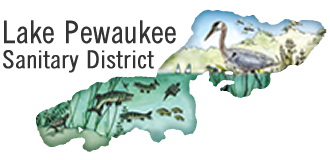The District started chemical control of aquatic plants in 1945 using arsenic compounds. The District used 2-4D for the control of milfoil between 1962 and 1985. We discontinued the use in 1985 for several reasons:
- 2-4D is not 100% selective and may impact certain native plants.
- In our lake, the areas that were treated in the short term showed a reduction in milfoil, but in the long term milfoil became more dominant because of its invasive nature.
- Although the short term effects are relatively understood, the long term sub-lethal effects are not.
- There is no long-term liability coverage available for the use of aquatic herbicides. The District can only get coverage for negligence or accidental spill.
In 1990 a group of over 20 people from all areas of the lake formed the Citizen Advisory Committee to independently study the chemical issue. They concluded that chemical treatment was not a good long term management tool for Pewaukee Lake.
Issues that the homeowner needs to consider when using aquatic herbicides:
- The State will issue a permit but the homeowner accepts all long term liability associated with the treatment.
- Homeowner’s insurance policies do not accept any liability for the use of aquatic herbicides.
- Not all plants in the pier areas are milfoil. Some of the natives may resist the treatment and not all “weeds” may be eliminated.
- Additional treatment may be needed later in the season.
- Local studies show that 2-4D may remain in the water column for over 30 days.
- Lethal and sub-lethal effects on aquatic life should be considered.
- Basic Information about 2,4-D (2,4-Dichlorophenoxyacetic Acid) in Drinking Water from the EPA
- 2,4-D from the EPA
- 2,4-D Chemical Fact Sheet from the Wisconsin DNR (.pdf file)
- 2,4-D Fact Sheet (Also known as: 2,4-Dichlorophenoxyacetic acid, Weed-B-Gone, Acme, Aquakleen) from the Wisconsin Department of Health Services
Alternatives to the use of chemicals for the pier areas are being practiced by literally hundreds of homeowners around the lake. Hand pulling, raking, or the use of a hand-held weed cutter for the removal of all types of plants is allowed within 30 feet of the homeowner’s pier. Milfoil and other exotics may be removed beyond 30 feet. All plant material must be removed from the water (shore pick-up). The homeowner may give permission to someone else to do the removal. This does not require a permit unless you are removing wild rice. See DNR web site.
Some of the local pier installers are now providing removal with hand-held cutters. Also check with your lawn service. Some of them are now providing cutting as well as raking service.
Pewaukee Lake Water Quality – Chemical treatment is being promoted as a way to stop the perceived decline in water quality that has occurred over the past twenty years since the District stopped their use. If we look at the facts from two studies over that time period it is evident that the lake has improved without the use of chemicals.
- The Trophic State is a measurement of nutrient enrichment. In 1984 Pewaukee Lake was classified as very eutrophic or on the bottom of the scale for water quality. In 2003 Pewaukee was classified as a mesotrophic lake, a major improvement.
- The Plant Diversity Index value has increased from 66.7 to 110.3, with the higher number indicating improvement.
- The increase in diversity of the benthic, or bottom dwelling invertebrates, indicates an improved lake.
- The fishery in Pewaukee in 2003 was considered outstanding, with 45 species in the lake including a State Threatened and a State Special Concern Species.







